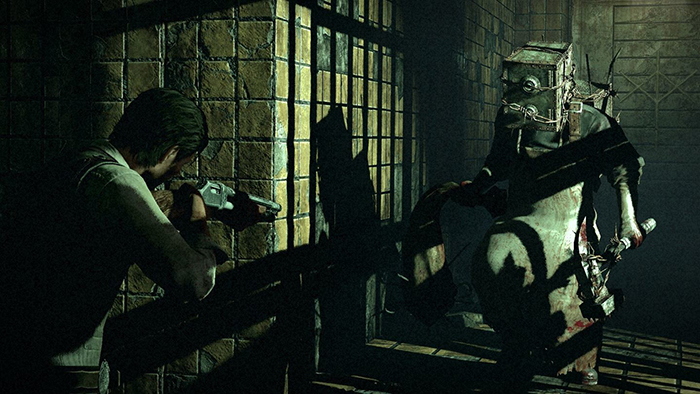Let’s get something out of the way before I give The Evil Within its praise. There are a couple things about this game that really bother me.
The black bars, top and bottom. I understand where the idea came from, but it just doesn’t work. Designer Shinji Mikami felt the need to make his game more cinematic, which meant adding the widescreen mode to mimic the effect you get at the movies. And while this is true, moviemaking methods don’t always cleanly adapt to video games even with frequent cutscenes. The most irritating part of the black bars is how they obscure items lying on the ground.
You can of course disable the black bars during gameplay, but doing so will make the framerate chug depending on the power of your PC. The subtitles come up extremely aggressive when they appear and disappear if you’ve disabled the widescreen mode, as well.
But enough complaining. The Evil Within really comes through with design. Although the stages are erratic and there’s not quite a clear timeline to anything, it sure looks good. Most of the areas you wander through are one of two things: run-down hospital or crumbling stone architecture. You’d think that bloody tile floors and dirty brickwork would get old quickly, but there’s so much to look at that you don’t even think about how often it’s in front of you.
The lighting is pretty standard for a survival horror game. You’ve got your basic swinging lamp casting crazy shadows, blaring white light that blinds you when you look into it, saturating red light that makes you second guess if that mysterious stain is blood or just dirty water, and yellow light that makes the halls feel warm but still offers no comfort.
The monsters (or, “the haunted”) fit well into any of these setups. You have your basic grunt-type enemies which are most of what you encounter, then you have a big guy with a chainsaw and a severely limited vocabulary, then a dude with a safe on his head who can teleport his body into the other piles of empty safes that just so happen to be lying around. Safe Man is my favorite mini-boss, just because of the way he taunts you by hitting the side of his “head” with a big hammer that he then turns on you if you get too close.
I shouldn’t forget about Ruvik himself. I am bothered by how overpowered he is, but then again, things would be far less interesting and flexible if he was just a simple shmuck with burn wounds and a crappy white hoodie. He’s in his basic human form for almost the entire game, but when push comes to shove at the end, he transforms into a weird Lovecraftian monster (with braces?) just to get his brain blown up by a convenient rocket launcher.
The pervasive theme of barbed wire is the kind of symbolic that you get immediately – people turned into monsters in horrible anguish, sharp and unstable hospital equipment and rebar-sprouting concrete, one of your weapons literally being called “the agony crossbow” – but it’s a fun kind of gimmick that grounds the experience. The game isn’t trying to be something it’s not, and I can seriously appreciate the honesty.
If I were to compare The Evil Within to anything, I’d say it’s like a really enthusiastic little cousin who just got into writing poetry. He’s at that age where he’s on the verge of being emo and he has a lot of feelings that he expresses through rough and edgy word choice. You cringe a little at first, but then you come to appreciate his antics and his passion for creation starts to rub off on you. You know he’ll grow out of it and improve his skills, but for now he’s just giving his all to what he thinks will move his audience.
The Evil Within improved its own dynamic with its sequel, mostly on a gameplay level but also in terms of vision. I’ll be going into detail a bit tomorrow about The Evil Within 2.


